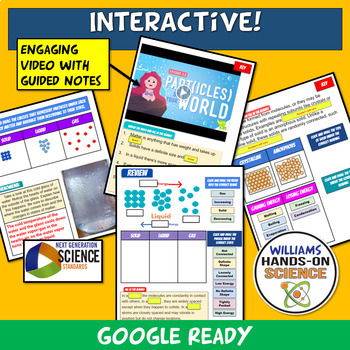States of Matter Solids Liquids Gases Reading Passages Worksheets
- Google Slides™

Description
This 45 minute activity is NO PREP and engaging! Students read, do an interactive worksheet, and watch a video with guided notes. If you are teaching the NGSS standard PS1.A: Structure and Properties of Matter this resource is perfect for you! This resource can be implemented in Google Classroom or printed for hard copies! This resource can be used as an introduction to Matter, scaffold, review or sub plan. This resource is great for in class one to one computer activity, distance learning, sub plan and/or homework!
Students first read about the differences between solids, liquids and gases and how energy effects states of matter.
Students watch a 3:31 minute video with guided questions.
Students click and drag answers and do fill in the blanks on an interactive worksheet
The resource has the following concepts:
Particles in a solid
Particles in a liquid
Particles in a gas
Energy
Atoms
Molecules
Matter
States of Matter
Amorphous Solids
Crystalline Solids
Melting
Condensation
Evaporation
Boiling Freezing
Take a look at my Chemistry bundle!
or
Google Ready NGSS PS1.A Structure & Properties of Matter Bundle
You get the following:
-Close Reading
-Link to video with guided notes
-Interactive worksheet
-Key
NGSS Standards:
Performance Expectations
Develop a model that predicts and describes changes in particle motion, temperature, and state of a pure substance when thermal energy is added or removed. MS-PS1-4
Disciplinary Core Idea (DCI): PS1.A: Structure and Properties of Matter
· PS1.A: Structure and Properties of Matter
· Substances are made from different types of atoms, which combine with one another in various ways. Atoms form molecules that range in size from two to thousands of atoms.
· Each pure substance has characteristic physical and chemical properties (for any bulk quantity under given conditions) that can be used to identify it.
· Gases and liquids are made of molecules or inert atoms that are moving about relative to each other.
· In a liquid, the molecules are constantly in contact with others; in a gas, they are widely spaced except when they happen to collide. In a solid, atoms are closely spaced and may vibrate in position but do not change relative locations.
· Solids may be formed from molecules, or they may be extended structures with repeating subunits (e.g., crystals).
· The changes of state that occur with variations in temperature or pressure can be described and predicted using these models of matter.
CCC's: Patterns
Observed patterns of forms and events guide organization and classification, and they prompt questions about relationships and the factors that influence them.
Thank you for taking a look!
Related Products
⭐ NGSS 46 Slide Matter PowerPoint with Warm Ups and Guided Notes
⭐ NGSS 5E Matter Lab Computer Simulation Close Reading Close Notes & Warm Up
⭐ NGSS Molecule Building Lab (Elements, Atoms, Compounds, Molecules, Formulas)
⭐ NGSS States of Matter Doodle Notes Graphic Organizer Concept Map
⭐ States of Matter Computer Lab: Close Reading & Cloze Notes
⭐ States of Matter/Chemical & Physical Changes Dancing Raisins Lab and C.E.R.
TERMS OF USE
• All rights reserved by Williams Hands On Science, Inc.
• This product is to be used by the original purchaser only.
• Intended for classroom and personal use only.
• Copying for more than one teacher, classroom, department, school, or school system is prohibited.
• This product may not be distributed or displayed digitally for public view.
• Failure to comply is a copyright infringement and a violation of the Digital Millennium Copyright Act (DMCA).
If there are any errors or questions, please contact me through TpT or email me at:
williamshandsonscience@gmail.com
Thank you for taking a look!
Please follow me on TpT for new products and check me out on Instagram for my products in action!





